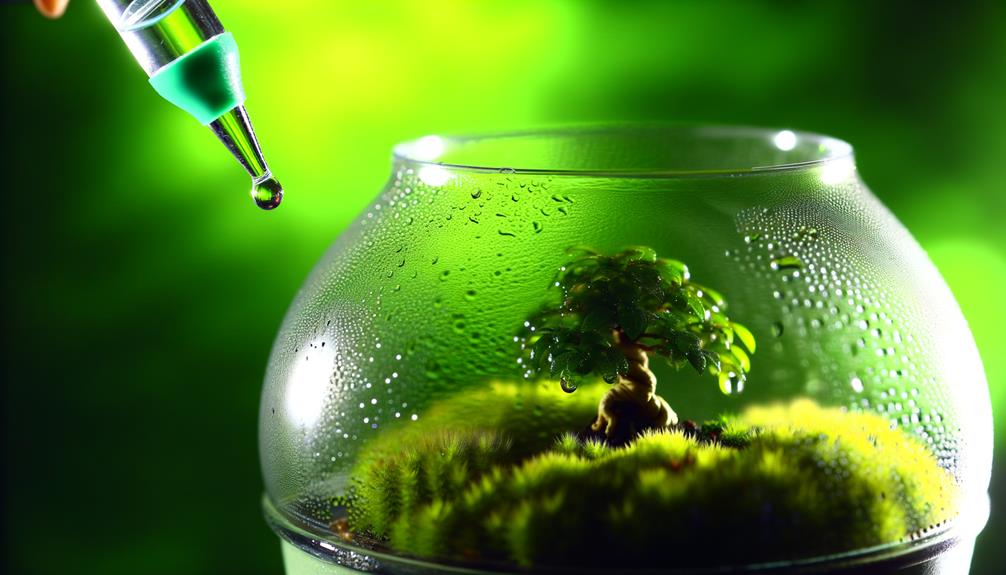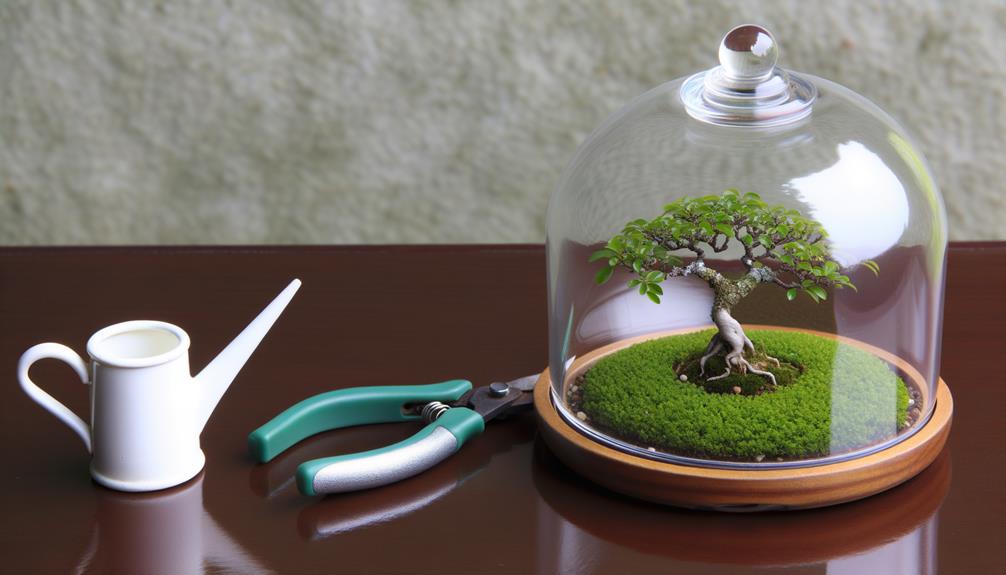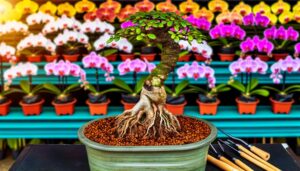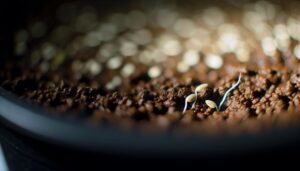How You Can Grow a Bonsai in a Terrarium
Yes, growing a bonsai in a terrarium is achievable by adhering to specific horticultural practices. Appropriate bonsai species include Ficus, Serissa, and Juniper.
Essential techniques involve root pruning, branch trimming, and maintaining an ideal leaf-to-root ratio. Selecting the right terrarium type—closed for high humidity or open for better airflow—is vital.
Soil composition must guarantee adequate drainage and aeration. Adequate light is provided through full-spectrum LED grow lights.
Temperature should range between 60-75°F with humidity levels of 50-70%. Mastering these techniques and more will lead to a thriving bonsai terrarium.
For those interested in detailed expertise, there is much more to uncover.

Key Takeaways
- Yes, you can grow a bonsai in a terrarium by selecting suitable species like Ficus, Serissa, and Juniper.
- Ensure proper soil composition with well-draining substrates like Akadama, pumice, and lava rock to prevent root rot.
- Maintain adequate light exposure using full-spectrum LED grow lights to support photosynthesis and growth.
- Monitor humidity and temperature levels with a hygrometer and thermometer, keeping humidity between 50-70% and temperature between 60-75°F.
- Regularly prune roots and branches to maintain the leaf-to-root ratio and prevent overcrowding within the terrarium.
Understanding Bonsai Basics

Understanding the basic principles of bonsai cultivation is vital for successfully growing these miniature trees within the controlled environment of a terrarium. Bonsai, derived from the Japanese art form meaning 'tray planting,' requires careful attention to the plant's horticultural needs. Key elements include root pruning, branch trimming, and maintaining a balanced leaf-to-root ratio.
Species selection is essential, as certain trees like Ficus, Serissa, and Juniper adapt better to confined conditions. Proper soil composition, often a mix of akadama, pumice, and lava rock, ensures adequate drainage and aeration. Additionally, understanding photoperiodism and guaranteeing sufficient light through artificial means, if necessary, is crucial.
Mastery of these basic principles provides the foundation for cultivating a thriving bonsai in a terrarium.
Terrarium Fundamentals
Terrarium fundamentals encompass the classification of terrarium types and the crucial care practices necessary for best plant health.
Closed terrariums maintain higher humidity levels, beneficial for moisture-loving species, while open terrariums provide better airflow, reducing fungal growth risks.
Necessary care tips include monitoring humidity, ensuring proper drainage, and selecting appropriate substrates to support bonsai health.
Types of Terrariums
Selecting the appropriate type of terrarium is vital for successfully growing a bonsai, as it directly influences the microclimate, humidity levels, and overall health of the plant. Different terrarium types offer varied environments, thus understanding their characteristics is important.
- Closed Terrariums: These provide high humidity and stable temperatures, ideal for tropical bonsai species requiring constant moisture.
- Open Terrariums: Suitable for bonsai species that prefer lower humidity and better air circulation, reducing the risk of fungal growth.
- Wardian Cases: Elegant, glass-framed cases that combine the benefits of both open and closed systems, offering controlled humidity and ventilation.
- Bottle Terrariums: Enclosed within a bottle, they offer high humidity but limited air circulation, suitable for moisture-loving bonsai.
Choosing the right terrarium type ensures the best growth conditions for your bonsai.
Essential Care Tips
Maintaining ideal conditions within a terrarium is necessary for the thriving growth of bonsai, encompassing precise control over factors such as light, water, temperature, and humidity.
Adequate light is vital; utilize full-spectrum LED grow lights to mimic natural sunlight.
Watering must be careful; overwatering can lead to root rot, while underwatering can cause desiccation.
Employ a hygrometer to monitor humidity levels, keeping it between 50-70% to emulate the bonsai's native environment.
Temperature should remain stable, ideally between 65-75°F, to prevent thermal stress.
Proper ventilation is essential to avoid fungal growth; consider small vents or periodic opening of the terrarium.
Substrate selection should guarantee proper drainage and nutrient availability, using a mix of akadama, pumice, and organic compost.
Choosing the Right Bonsai

Choosing the right bonsai species for a terrarium setting requires taking into account various important factors. This includes the species' ability to thrive in high humidity levels and low light conditions. The size and growth rate of the bonsai must be suitable for the space limitations of the terrarium to guarantee ideal development and upkeep.
Species like Ficus, Serissa, and Fukien Tea are frequently suggested because of their manageable growth habits and durability in regulated settings.
Suitable Bonsai Species
Identifying the most appropriate bonsai species for terrarium cultivation requires an understanding of plant physiology, microenvironment requirements, and species-specific growth patterns. Certain species are more adaptable to the restricted, humid environment of a terrarium. Key considerations include tolerance to low light, humidity levels, and compact growth habits.
The following species are particularly well-suited:
- Ficus retusa: Known for its resilience and ability to thrive in varied light conditions.
- Schefflera arboricola: Flourishes in high humidity and indirect light.
- Serissa foetida: Prefers moisture and can withstand lower light levels.
- Hedera helix (English Ivy): Compact growth and high tolerance to humidity.
Selecting these species guarantees compatibility with terrarium conditions, promoting healthy growth and longevity within the confined space.
Size and Growth Rate
Understanding the size and growth rate of bonsai species is pivotal for ensuring that the plant remains manageable within the confined space of a terrarium. Selecting species with slow growth rates and diminutive stature is essential. Species such as Ficus retusa, Serissa japonica, and Juniperus procumbens are ideal candidates due to their compact growth forms and minimal vertical expansion. Consideration of internodal length, leaf size, and root structure is also critical for maintaining the aesthetic proportions of the bonsai. The table below outlines key characteristics for selecting suitable bonsai species for terrarium environments.
| Species | Growth Rate |
|---|---|
| Ficus retusa | Slow |
| Serissa japonica | Slow to Moderate |
| Juniperus procumbens | Slow |
| Portulacaria afra | Slow to Moderate |
Selecting a Suitable Terrarium
The perfect terrarium for cultivating a bonsai must provide ideal light exposure, humidity control, and sufficient airflow to guarantee robust growth and health. When selecting a terrarium, consider the following factors:
- Material:
Opt for clear glass or high-quality acrylic to secure maximum light penetration, essential for photosynthesis.
- Size:
Choose a terrarium that accommodates the bonsai's growth, allowing for both root and canopy expansion.
- Ventilation:
Secure the terrarium has adjustable vents or openings to maintain proper airflow, preventing mold and mildew.
- Humidity:
Select a terrarium with a design that allows for controlled humidity levels, as excessive moisture can lead to root rot.
Soil and Substrate Considerations

When cultivating a bonsai within a terrarium, selecting an appropriate soil mixture is crucial to ensure ideal drainage and aeration, thereby preventing root rot and promoting healthy growth.
The substrate must provide a balanced supply of macronutrients and micronutrients essential for bonsai development. Understanding the specific nutrient requirements of the chosen bonsai species will guide the formulation of a tailored soil composition.
Proper Soil Mixture
Selecting the appropriate soil mixture for a bonsai in a terrarium is crucial for ensuring proper drainage, aeration, and nutrient availability. The unique environment of a terrarium necessitates a specialized substrate to support the physiological needs of the bonsai.
A well-formulated soil mixture typically includes:
- Akadama: A hard-baked Japanese clay that retains moisture yet allows for excellent drainage.
- Pumice: A volcanic rock that provides aeration and prevents soil compaction.
- Lava Rock: An aggregate that maintains structure and aids in water retention.
- Organic Compost: Adds necessary nutrients and enhances microbial activity.
Each component serves a specific function, creating a balanced medium that fosters root health and overall plant health within the enclosed terrarium system.
Drainage and Aeration
Ensuring sufficient drainage and aeration in the soil and substrate is essential for preventing root rot and promoting vigorous growth in bonsai within a terrarium. The confined space of a terrarium requires a well-draining substrate to prevent waterlogging, which can lead to anaerobic conditions harmful to root health.
A mixture incorporating components such as akadama, pumice, and lava rock is recommended, as these materials provide both adequate drainage and necessary aeration. Additionally, a layer of coarse material at the base can further improve drainage.
The substrate must maintain a balance between moisture retention and air permeability, ensuring roots receive enough oxygen while avoiding excessive water retention. Regular monitoring and adjustments are key to maintaining ideal conditions for bonsai health.
Nutrient Requirements
Proper nutrient management is essential for the healthy development of a bonsai growing in a terrarium environment. Selecting the appropriate soil and substrate ensures peak nutrient availability and root health. Key considerations include:
- Soil Composition: Utilize a well-draining bonsai soil mix, typically composed of akadama, pumice, and lava rock, to maintain balanced moisture and aeration levels.
- Nutrient Supplementation: Regularly apply a balanced, slow-release fertilizer to provide essential macro and micronutrients, such as nitrogen, phosphorus, and potassium.
- pH Levels: Maintain soil pH between 6.0 and 6.5 to enhance nutrient uptake and root function.
- Organic Matter: Incorporate organic components like sphagnum moss or composted bark to improve soil structure and nutrient retention.
Adhering to these guidelines will promote vigorous growth in a contained terrarium setting.
Light Requirements
Adequate light exposure is vital for the best photosynthetic activity and overall health of bonsai trees grown in terrariums. Photosynthesis rates are directly influenced by light intensity and quality, requiring the provision of sufficient artificial or natural light sources.
High-output fluorescent or LED grow lights with a color temperature between 5000K and 6500K are ideal for promoting vigorous growth. It is important to make sure that the bonsai receives 10-12 hours of light daily to mimic natural sunlight cycles.
Moreover, the terrarium glass must remain clear to prevent light obstruction. Periodic rotation of the bonsai within the terrarium can guarantee even light distribution, preventing phototropic responses which could lead to uneven growth patterns.
Watering Needs

Maintaining ideal hydration levels is crucial for the health and growth of bonsai trees within terrariums. Proper watering practices guarantee that the roots receive sufficient moisture without causing waterlogging, which can lead to root rot. Here are essential steps to manage the watering needs effectively:
- Assess Soil Moisture: Utilize a moisture meter to accurately gauge the soil's hydration level.
- Watering Frequency: Water when the topsoil feels slightly dry to the touch, avoiding a fixed schedule.
- Drainage: Guarantee the terrarium has adequate drainage layers to prevent stagnation and facilitate oxygenation.
- Watering Method: Employ a misting technique to evenly distribute water, simulating natural precipitation.
Temperature and Humidity
Optimal temperature and humidity levels are essential for the physiological processes and overall health of bonsai trees cultivated within terrariums. Bonsai trees generally thrive in temperatures ranging from 60-75°F (15-24°C). Excessive fluctuations can stress the plant, impairing growth and vitality.
Humidity levels should mimic the bonsai's natural environment, typically between 50-70%. High humidity aids in transpiration and nutrient uptake, while preventing desiccation of delicate foliage. Conversely, overly humid conditions can promote fungal growth and root rot.
Utilizing a hygrometer and thermometer ensures precise monitoring, while misting systems or pebble trays can help maintain ideal conditions. Maintaining these parameters is crucial for fostering a microenvironment conducive to the bonsai's long-term health and aesthetic appeal.
Pruning and Maintenance

Pruning and maintenance are critical components in the cultivation of a bonsai within a terrarium, ensuring both structural integrity and peak health of the miniature tree. Regular pruning facilitates proper air circulation and prevents fungal infections.
Essential maintenance practices include:
- Structural Pruning: Shape the tree by removing unwanted branches to maintain the desired form.
- Leaf Pruning: Thin the foliage to enhance light penetration and photosynthetic efficiency.
- Root Pruning: Trim the roots periodically to prevent overcrowding and encourage a robust root system.
- Cleaning: Remove dead leaves and debris to reduce the risk of pest infestations and diseases.
Understanding and implementing these techniques promotes a healthy, aesthetically pleasing bonsai, optimizing its growth within the confined environment of a terrarium.
Common Challenges
Despite the allure of cultivating bonsai within a terrarium, several challenges can greatly impact the plant's health and growth. Elevated humidity levels, inherent to terrariums, may promote fungal growth and root rot, conditions detrimental to bonsai. Proper humidity control is crucial to avoid such issues. Light management also becomes critical; insufficient light can lead to etiolation, while excessive light can cause leaf scorch. Finding the right balance often necessitates artificial lighting solutions.
Pest infestations pose another challenge, particularly from aphids and spider mites. These pests can proliferate in the closed environment of a terrarium. Regular monitoring and timely intervention with biological or chemical treatments are essential to prevent infestations from harming the bonsai. Understanding these challenges and their mitigation strategies is key to maintaining a thriving bonsai within the unique microhabitat of a terrarium.
Benefits of Bonsai Terrariums

Incorporating bonsai in terrariums offers multiple benefits, including enhanced humidity control and a stable microenvironment conducive to the plant's delicate growth requirements. These controlled conditions facilitate ideal growth and reduce the risk of common stress factors.
Specific advantages include:
- Humidity Regulation: Terrariums maintain higher humidity levels, essential for the hydration needs of bonsai trees.
- Microclimate Stability: The enclosed environment buffers against sudden temperature fluctuations, promoting consistent growth.
- Pest and Disease Reduction: The contained space limits exposure to pests and pathogens, reducing the incidence of infestations.
- Aesthetic Appeal: Combining the art of bonsai with the visual charm of a terrarium creates an enchanting display that enhances interior spaces.
These benefits collectively improve the overall health and longevity of bonsai trees in terrariums.
Inspiration and Ideas
Exploring various design concepts can ignite creativity and demonstrate the potential for integrating bonsai trees within terrarium environments to create unique, self-sustaining ecosystems.
Consider utilizing species such as Ficus retusa or Crassula ovata, which thrive in high-humidity, controlled environments.
Incorporate layers of activated charcoal, sphagnum moss, and substrate to ensure effective drainage and prevent root rot.
Position miniature rocks and driftwood to mimic natural landscapes, enhancing aesthetic appeal.
Employ LED grow lights to mimic natural sunlight, guaranteeing photosynthetic requirements are met.
Regular pruning will maintain the diminutive stature of the bonsai, promoting vigorous growth.
Conclusion
To wrap up, cultivating a bonsai within a terrarium merges ancient horticultural practices with modern botanical innovation, akin to a harmonious symphony between nature and artifice.
This intricate endeavor demands meticulous selection of species, precise environmental control, and diligent maintenance.
Mastery of these elements can transform a simple glass enclosure into a microcosm of natural beauty, reminiscent of the delicate balance found in ecosystems such as the cloud forests.
Such an undertaking not only enhances aesthetic appeal but also promotes ecological mindfulness.






